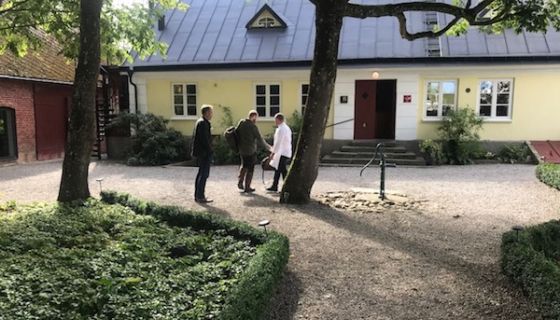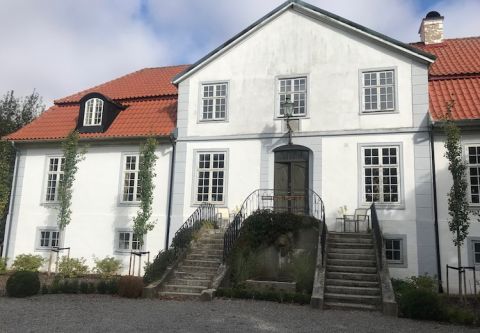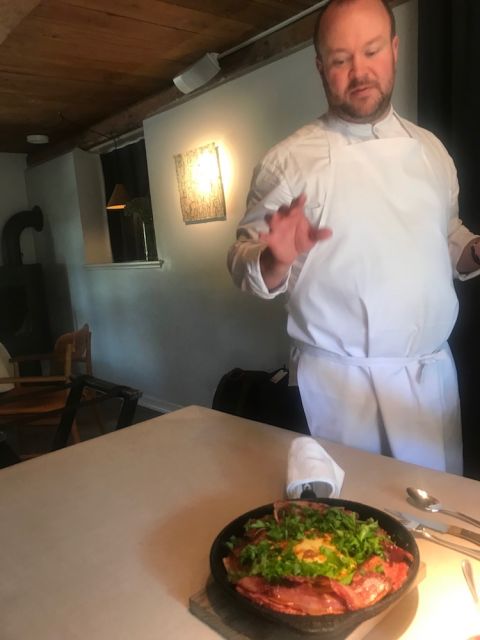In the space of less than twelve hours I was to see Daniel Berlin, 36, in the two very different uniforms that I believe he spends most of his waking time wearing.
I first met him at 7pm wearing what is his more recognisable chefs’ whites as he greeted my Swedish friend and myself on the steps of the two-star restaurant he has so successfully established in the small village of Skåne Tranås in southern Sweden.
Berlin was to collect us again at 7am the following morning dressed this time very much as the hunter. He wore a Harkila of Scandinavia hunting top, GoreTex trousers and thick, heavy boots.
Our hunting expedition, despite the sighting of scores of fallow deer, the smell of even more numerous wild boar, and noise from the rutting stags, was ultimately fruitless. But I was to learn one trait that is obviously common to both Berlin the chef and Berlin the hunter.
As he instructed this neophyte hunter, he kept on emphasising that ‘above all, patience is required’. This quality, not necessarily associated with chefs, has been the key to his obvious success.
It took patience to persuade the former owners of his restaurant to sell to him. It had been a French bistro where Berlin had worked one Easter Sunday lunch when they served 180 customers, removing any doubt in Berlin’s mind as to its potential. It took patience since then to mastermind its transformation into a highly ambitious showcase for his cooking that serves a 2,150 Swedish kroner (£175) menu to a maximum of 25 customers.
But he cannot claim all the credit. This must be shared with his parents, Per-Anders and Irene, who followed their son on his mission. Daniel’s father initially worked as the sommelier while his mother is responsible for the expanding garden, now over an acre surrounding the restaurant.
The recent opening of the game season seemed a propitious moment to visit this restaurant, surrounded as it is by many ‘castles’, as the Swedes call them, many with their own hunting grounds. I asked Berlin whether these natural resources had been a motive in his move from Malmö 10 years ago. ‘No,’ he replied. ‘I only started shooting eight years ago because I believe that it is vitally important that there is someone in the kitchen who is capable of instructing the rest of the brigade in how all the elements of handling this important source of protein are gathered.’
This knowledge was put to outstandingly good use in the first of the 17 courses we were served. It consisted of a bowl of warming, beautifully judged clear broth made from wild duck and two delicate, crisp cylinders made from the ducks’ hearts and tongues.
Of the 11 small preambles to the main course that followed, three were as exceptional. The first was a small square of fermented wheat topped with thin slices of hand-dived blue mussels. The second was a bowl of thinly-sliced perch on top of equally thinly-sliced yellow beetroot, while the final dish was a loin of cod on top of diced rhubarb and whelks. Then Berlin came in and reduced the dining room to silence.
He had in his hands four whole celeriac that had been grilled over birch twigs. These he proceeded to slice open before scooping out the contents and handing them in bowls to his four friendly and knowledgeable waiting staff. They then topped them up with the oil of the stems and a broth made from the remains. This warmed us all up for a quick trip outdoors.
Here, round a pair of braziers, the other guests gathered while the waiting staff reset the dining room and I spent the time talking to the kitchen brigade as they prepared partridge over a Japanese grill. This was subsequently served as a breast topped with whole and diced chanterelles and elderflower berries.
There then followed three exceptional desserts. The first, of Victoria plums and meadowsweet, combined richness and acidity; the second of colostrum, the rich milk a cow provides having given birth, with blueberries (pictured above); and the third, served in the well-heated greenhouse, of a scoop of salted egg white ice cream topped with the thinnest meringue and a caramel sauce.
Berlin is aware of the risks of his unusual approach to hospitality. ‘I want to impress on my brigade that we stand or fall by our sales. There is nobody else with deep pockets behind us. The restaurant has had a positive effect on the village as a whole and I would like to see this continue.’
This trip also provided me with first-hand evidence of climate change in southern Sweden. In the gardens, Irene pointed out that a wet spring had significantly reduced the apple crop but that for the first time peaches had ripened on their trees.
And in the cold store, Daniel showed me an unexpected bonus. ‘Our forager is Canadian and recalled the plethora of morel mushrooms after the fires there. Last year we had terrible fires in Sweden and so he and his pal went looking for them. Over a fortnight they came back with 110 kg, some of which we shared with Noma in Copenhagen, but I still have plenty left which, having been dried, will go on my menu in January.’
Another reason to return.
Restaurant Daniel Berlin Diligensvägen 21, 27392 Skåne Tranås, Sweden +46 417 203 00
More local recommendations
As well as the pleasures of eating and drinking in Daniel Berlin’s restaurant in Skåne Tranås, and the excitement of an early morning walk behind a chef with a loaded shotgun, there were several other very different sources of pleasure to be enjoyed during my 36-hour stay. Here are several of them.
Where to stay As I mention above, this farming region is home to numerous ‘castles’ that belong to wealthy individuals. This should not conjure up an image of turrets or anything in the Scottish mould because these buildings are more in the style of Swedish country mansions often built as long ago as the seventeenth century. Many have proved attractive to those from outside this region who have made sufficient money to see the long-term benefits of moving here.
One such couple are Jamie White and Joakim Silvandersson who have converted the estate at Kåselholm (www.kaseholm.com) into an extremely comfortable home and offer bed and breakfast to parties of six or more. White is American and his partner is Swedish but both of them have spent many years travelling and picking up on what the curious traveller will want and need when they come to stay. Their house, above. is extremely comfortable; full of curios, including a talkative cagebird in the kitchen; and the walls and the bookshelves are full of the manifestations their curiosity.
So too are the grounds, which are predominantly Silvandersson’s responsibility when he is not looking after three dogs and a couple of cats. These include a flock of Swedish chickens; Swedish rams and ewes; Svanske geese; and a crazy rabbit. Of the numerous outhouses, one includes a teepee in which the guests sit on hay bales.
What to drink As I mentioned in my article, the service at Daniel Berlin’s restaurant was that rare combination of professionalism, friendliness and charm. That has a lot to do, in my opinion, with the fact that the restaurant is led by its founder and owner combined with the warmth of Rebecka Lithander who doubles in the roles of general manager and sommelier.
Now I know that even when I travel alone, my wife’s reputation goes before me and I am likely to be spoilt when it comes to the wine selection. But here I was completely surprised, and delighted, by the red wine Lithander had chosen for our table.
Not that the white wine she chose, a 2017 Meursault, Le Lomonzin from Bernard Bonin was unimpressive. It was rich with honey on the finish and was a great pairing with the numerous small dishes that preceded our main course of partridge.
And it was here that Lithander surprised us both with her choice of a bottle of Swiss Gamay 2010 from Domaine de Beudon, a winery that I had never heard of, let alone drunk before this meal. This winery, high up at 1,200 m in the Valais (the label promises ‘Les vignes dans le ciel’) was founded by the late Jacky Granges, has since its outset specialised in less commonplace grape varieties. In this case the treatment of the Gamay grape was most impressive and this is a wine I will definitely look out for on my travels.
What to buy In my article Berlin refers to the various ways the village has smartened itself up in the 10 years since he opened his restaurant here. One manifestation of this is the transformation of the former schoolhouse in the village, right next door to the restaurant, into Svenska Kakaobolaget, the Swedish Chocolate Company, www.kakaobolaget.se
Unfortunately, I was unable to visit the factory/shop as it was closed on the Friday night and I did not have time on the Saturday when it was open. That, however, is my loss and I more than made up for this by enjoying several of their chocolates on my return. They are delicious.
Fredrik and Ulrika Alverin opened the business in 2013 and source the best cocoa beans from around the world before turning them into chocolates. These chocolates are imported into the UK by that great chocolate lover, Spencer Hyman, of Cocoa Runners, www.cocoarunners.com
What to eat ‘Aggakaga’ or eggy cake is my advice. This is the dish that my Swedish friend was talking about several days before my visit and he persuaded one of the chefs in Daniel Berlin’s kitchen to cook it for us for Saturday lunch. Daniel is seen serving it below.
As such, it was perfect. Traditionally, this was a dish for those working in the fields as it could be wrapped, when cold, and eaten quite easily. But here it was served hot and was absolutely delicious. The thick egg pancake is topped with two kinds of bacon, cooked in plenty of vinegar, and is traditionally served alongside bowls of lingonberries and here another bowl of fine stewed apple. The dish is eaten by cutting slices of the pancake and topping these with the bacon, lingonberries and apple. It is very, very filling and dangerously moreish.















